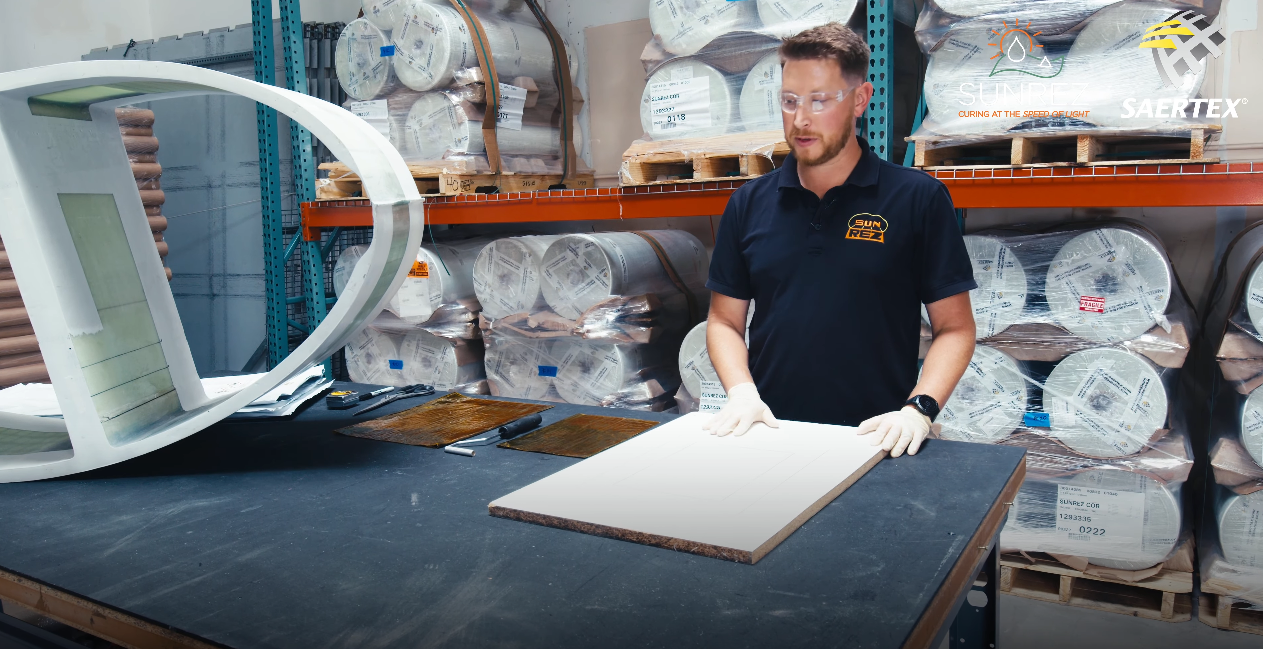The wind turbines are an essential component in the transition to renewable energy, but their structural elements must withstand extreme environmental conditions. Wear and damage can reduce the performance of wind blades, causing costly maintenance of wind turbines and long downtime.
Restoring damaged components quickly is critical to ensure efficient operation of wind power plants. In this guide, you will discover how to carry out a wind blade repair effective, using composite materials from SAERTEX, to reduce costs and downtime.
Preparation of the damaged area
Before starting the wind blade repair, it is essential to prepare the affected area through the following steps:
- Identification of the damage: Mark the area to be treated.
- Cleaning: remove dirt and debris to avoid contamination during repair.
- Removal of damaged material: remove compromised layers to expose healthy composite.
- Surface preparation: apply a surface primer or filler, depending on the depth of the damage.
Proper preparation ensures a durable, high-performance repair, minimizing the risks of future maintenance of wind turbines.
Advanced materials for wind blade repair
The use of innovative materials makes it possible to perform a repair of wind turbines faster and more durable. Sunrez prepregs, compatible with SAERTEX UD, Combi and Biax fabrics, offer numerous advantages:
- Rapid polymerization with UV light.: reduces turbine downtime.
- Availability of versions with and without styrene: for reduced environmental impact.
- Full UV protection: These prepregs are supplied premixed and photoinitiated between a black UV backing film, a clear top film, and a UV blocking film.
These advanced materials allow the blade structure to be consolidated without compromising aerodynamics or strength.
Wind turbine blade maintenance: material application
To obtain a wind blade repair effective, a precise procedure must be followed:
- Protection from sunlight: work in shade or use the orange UV protective film.
- UV primer application: distribute evenly over the area to be treated; a thickness of about 5 mils is optimal, but 3-25 mils is acceptable. The primer can be left wet or pre-cured before prepreg application.
- Positioning the prepreg: remove the black protective film and apply the prepreg to the damaged surface. Carefully align the prepreg and be sure to place it precisely according to the engineer’s instructions. There is no need to rush because the reaction will not start until the UV light is applied.
- Compression and adhesion: use a roller to eliminate air bubbles, starting from the center and working outward and ensure perfect adhesion.
- Adding layers: if necessary, remove both the UV protective film and the clear film and add more layers as required. Make sure each layer is well pressed and free of wrinkles or bubbles. Avoid squeezing out excessive amounts of resin.
Polymerization and finishing
How to. Polymerize the prepreg with UV light or simply expose it to sunlight.
The UV-blocking film allows precise control of the curing process. As soon as the patch is exposed to light, exothermia begins immediately, resulting in rapid curing in less than 5 minutes under UV light and less than 10 minutes under direct sunlight.
Up to eight layers can be cured at one time. If the desired thickness is greater, lay down the first few layers and remove both films from the top before curing. This leaves a tacky surface for the remaining prepregs to adhere to. Leaving the clear film on the top layer provides a hard, glassy surface that is perfect for sanding.
Once the clear film is removed, the patch can be prepared for painting. No post-curing or waiting time is required for complete curing.
Reduce downtime by using innovative materials
By following these steps, it is possible to perform a wind blade repair efficiently, reducing the costs of maintenance of wind turbines and ensuring a long operational life. Thanks to the use of innovative prepregs and UV curing, the repaired blade is ready for use in less than 10 minutes, significantly reducing turbine downtime. Learn about Saertex products for wind blade maintenance and contact us if you need clarification on material applications.
If you want to learn more about wind blade maintenance, we recommend reading this other article: How to optimize wind turbine maintenance.



